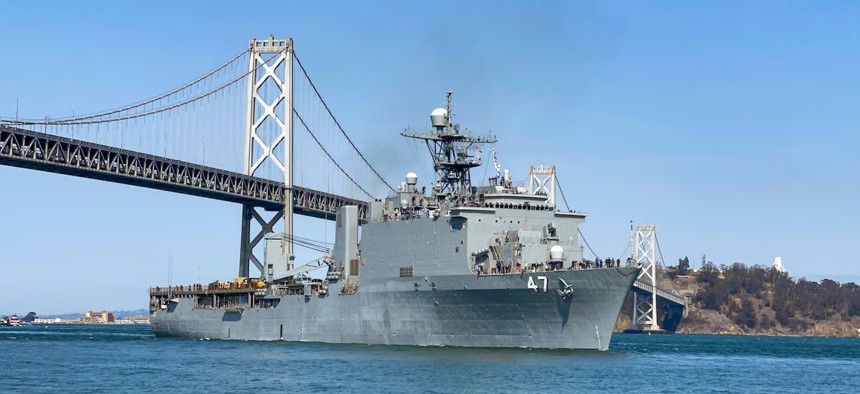
USS Rushmore (LSD 47) crosses under the San Francisco-Oakland Bay Bridge, Oct. 4, arriving for San Francisco Fleet Week 2021. U.S. Navy/MC2 Jasen Moreno-Garcia
Fewer Than 1/3 of Navy’s Amphibious Ships Are Ready to Deploy
“We can’t live with that,” Marine commandant says after high-profile missions were delayed or scuttled.
The readiness of the Navy’s amphibious fleet is low—really low, the Marine commandant said.
“I woke up this morning, checked what's the readiness rate. It's 32 [percent]. We can't live with that. We can't live with a 32 percent readiness rate. And over the last decade it’s below 50” percent, Gen. David Berger said Thursday at a Capitol Hill event hosted by the Amphibious Warship Industrial Base Coalition, a lobby group for amphib builders.
The readiness rate is the proportion of ships that can deploy as part of a three-ship amphibious ready group, Maj. Joshua Larson, the commandant’s spokesman, told Defense One.
Over the past decade, the readiness rate of the amphibious fleet has averaged 46 percent, from a high of 55 percent in 2012 to the record low of 39 percent in 2015. It averaged 45 percent last year, Larson said.
The current 32-percent mark is just a “snapshot”—but if it doesn’t come up, 2023 will set a new record low.
Larson ascribed the low readiness to “ship maintenance.” The ships are maintained and operated by the Navy.
Over the past 13 months, the Marines have twice been unable to deploy to urgent missions. In February 2022, maintenance problems delayed an emergency response to the Ukraine invasion. And last month, the Corps lacked the ships it needed to send Marines to help earthquake victims in Turkey and Syria.
“It's not just the amphibious ships and you've heard the [chief of naval operations] talk about readiness,” Berger said. “We've got to improve that. Because if we can't have the readiness, we won't be ready to respond. And you heard about Turkey a couple of minutes ago...And that might be a humanitarian crisis like an earthquake, or a typhoon, or a conflict. Either way, the maintenance, the readiness, it’s a direct impact, because the sailors and Marines have to have that vessel to go.”
The operational availability of ships is “the biggest problem” for the Navy when it comes to readiness challenges for its fleet, Bryan Clark, a senior fellow at the Hudson Institute, said Thursday during Defense One’s State of the Navy event.
“You hear the submarine force talking about how you've got a large percentage of the submarine fleet on any given day that's in the shipyard, unable to get out on time,” Clark said. “You've got surface combatants that can't get into the shipyard on time or out on time, because of the lack of availability of dry docks. And then on top of that, you've got ships that are taking too long in maintenance periods because new ships are becoming increasingly complicated, and they're also finding that they're in worse condition.
Berger said the near-term answer is not to retire the dock landing ships, all of which are at least three decades old.
“We have to have the inventory not less than 31. To me, that's a combination of old and new. We cannot decommission a critical element without having the replacement in our hand. We can't do that. Or else back to risk,” Berger said. “So the decommissioning of the LSDs to me is directly tied to the inventory as fast as we can procure and field. Maintenance, readiness, as the CNO has said for four years, is a key factor here. The goal, the Navy’s goal, 80 percent readiness. We got a long way to go.”





